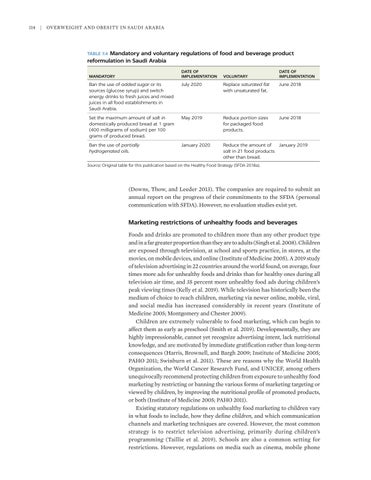114
|
Overweight and Obesity in Saudi Arabia
TABLE 7.4 Mandatory and voluntary regulations of food and beverage product reformulation in Saudi Arabia DATE OF IMPLEMENTATION
MANDATORY
VOLUNTARY
DATE OF IMPLEMENTATION
Ban the use of added sugar or its sources (glucose syrup) and switch energy drinks to fresh juices and mixed juices in all food establishments in Saudi Arabia.
July 2020
Replace saturated fat with unsaturated fat.
June 2018
Set the maximum amount of salt in domestically produced bread at 1 gram (400 milligrams of sodium) per 100 grams of produced bread.
May 2019
Reduce portion sizes for packaged food products.
June 2018
Ban the use of partially hydrogenated oils.
January 2020
Reduce the amount of January 2019 salt in 21 food products other than bread.
Source: Original table for this publication based on the Healthy Food Strategy (SFDA 2018a).
(Downs, Thow, and Leeder 2013). The companies are required to submit an annual report on the progress of their commitments to the SFDA (personal communication with SFDA). However, no evaluation studies exist yet.
Marketing restrictions of unhealthy foods and beverages Foods and drinks are promoted to children more than any other product type and in a far greater proportion than they are to adults (Singh et al. 2008). Children are exposed through television, at school and sports practice, in stores, at the movies, on mobile devices, and online (Institute of Medicine 2005). A 2019 study of television advertising in 22 countries around the world found, on average, four times more ads for unhealthy foods and drinks than for healthy ones during all television air time, and 35 percent more unhealthy food ads during children’s peak viewing times (Kelly et al. 2019). While television has historically been the medium of choice to reach children, marketing via newer online, mobile, viral, and social media has increased considerably in recent years (Institute of Medicine 2005; Montgomery and Chester 2009). Children are extremely vulnerable to food marketing, which can begin to affect them as early as preschool (Smith et al. 2019). Developmentally, they are highly impressionable, cannot yet recognize advertising intent, lack nutritional knowledge, and are motivated by immediate gratification rather than long-term consequences (Harris, Brownell, and Bargh 2009; Institute of Medicine 2005; PAHO 2011; Swinburn et al. 2011). These are reasons why the World Health Organization, the World Cancer Research Fund, and UNICEF, among others unequivocally recommend protecting children from exposure to unhealthy food marketing by restricting or banning the various forms of marketing targeting or viewed by children, by improving the nutritional profile of promoted products, or both (Institute of Medicine 2005; PAHO 2011). Existing statutory regulations on unhealthy food marketing to children vary in what foods to include, how they define children, and which communication channels and marketing techniques are covered. However, the most common strategy is to restrict television advertising, primarily during children’s programming (Taillie et al. 2019). Schools are also a common setting for restrictions. However, regulations on media such as cinema, mobile phone






